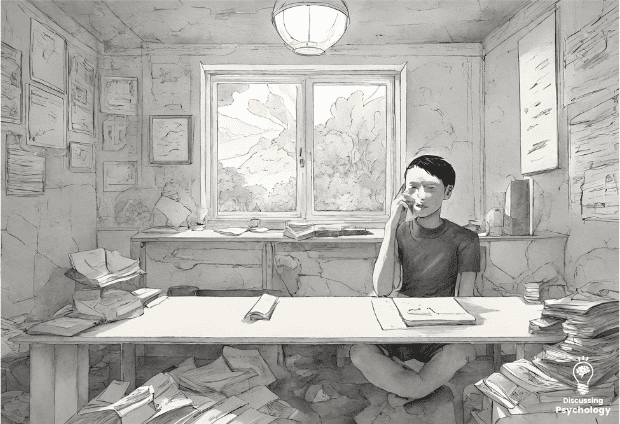Although maladaptive daydreaming (MD) isn’t yet clinically recognized, emerging research shows that potentially millions of people globally could suffer from it.
But how common is MD really? Is it a rare condition?
Here’s what current research has revealed on the topic.
Is maladaptive daydreaming rare?
A study from 2022 showed a prevalance rate for maladaptive daydreaming of 2.5%.
So that’s an estimated 1 in 40 individuals who daydream excessively to the point where it causes impairment and dysfunction in their lives.

Keep in mind this study tested 1023 individuals for symptoms of MD, across the Jewish-Israeli population.
Differences in how prevalent mental health conditions are and how exactly they are experienced may vary significantly between cultures.
So, while testing over a thousand individuals represents a solid start to the research into maladaptive daydreaming rarity, findings must be carefully generalized to other groups or nationalities.
Still, if you’re living with maladaptive daydreaming and want to know how much of the population share what you’re going through, the figure of 2.5% is the best we currently have.
Curious if you daydream too much? Complete our online test maladaptive daydreaming test here.
How does maladaptive daydreaming prevalence compare to other disorders?
| Disorder | 12-month prevalence |
| Generalized Anxiety Disorder | 3.1% |
| Panic Disorder | 2.7% |
| Phobias | 9% |
| OCD | 1.2% |
| Depression | 8.4% |
The above table shows the number of people affected by some of the most common mental health disorders in any given 12-month period.
Based on the prevalence figure of 2.5%, MD is less common than disorders like depression, general anxiety, and phobias but has a comparable rate to other conditions such as panic disorder.
While it may seem small, 2.5% equates to millions of people worldwide.
Given that this figure is broadly in line with the occurrence rates of other mental health disorders, which are much more well-understood, these figures highlight the need for further research into MD.
What else do we know about MD prevalence rates?
The prevalence study also gives us a first look at how MD may affect different groups of people differently. Some significant findings include the following:
Age differences
Maladaptive daydreaming was significantly more common in younger, student-age adults. The prevalence of the disorder in this age group is 8.5%.
There are a few possible reasons: daydreaming and mind wandering inevitably decrease as we get older, and we become less preoccupied with what could be and more set in our ways.
It’s also likely that the increased screen time and interest in fantasy and imagination seen in younger adults play a part in the tendency towards unhealthy levels of daydreaming.
Sex differences
While previous studies suggested that women are more likely to be affected by maladaptive daydreaming than men, this study did not find any gender differences in prevalence rates.
The authors speculate that perhaps women are more likely to come forward to talk about MD than men, hence being over-represented in prior research, but are not more likely to suffer from the condition overall.
Maladaptive daydreaming is not normally distributed
This one is a bit technical, so bear with me. Most traits and thought patterns are normally distributed (called the bell curve distribution).
The distribution implies that most people fall in the middle of the scale for any given trait, with fewer people at each extreme.
This is not the case for maladaptive daydreaming.
Different aspects of MD are “clumped” together, just like symptoms of other mental health disorders, meaning that if you have one, you are statistically much more likely to have other mental health disorders.
In simple terms, it means MD is very all-or-nothing: you have the condition and experience all its symptoms, or you don’t.
Comorbidity
We also know from separate research conducted in 2017 that MD is frequently experienced alongside other mental health conditions.
The researchers found that 75% of MD patients also lived with three other diagnosed conditions, hinting at a complex web of shared risk factors, underlying traits, and overlapping symptoms.
| Additional condition | % of MD patients diagnosed |
| ADHD | 76.9% |
| OCD | 53% |
| Social anxiety disorder | 43.5% |
| Generalized anxiety disorder | 28% |
This research shows that, for people with MD, additional complexities and challenges through comorbid disorders are the norm, not the exception.
However, we don’t know how the stats look the other way around when 77% of people with MD also have ADHD: We do not know what proportion of the general population with ADHD also have MD.
Understanding how the link works in both directions may help us understand the relationship between these conditions more clearly.
It’s not just you
Disappearing into your private fantasy world may feel like an intensely personal problem that no one else would understand.
However, the research shows it’s an issue many thousands worldwide face.
So if you’re living with MD and struggling to fit your real life around your imaginary one, you can at least take heart from knowing you aren’t the only one struggling.
- Anxiety & Depression Association of America. (n.d.). Anxiety disorders—Facts & statistics. https://adaa.org/understanding-anxiety/facts-statistics?gclid=CjwKCAjwtuOlBhBREiwA7agf1lqVBHS3MgNZj2gVuozQY4cgX44NIkz6a-8wYTDVCK3vCAHxm1KhSBoCQaoQAvD_BwE
- Jackson, J. D., & Balota, D. A. (2012, Mar.). Mind-wandering in younger and older adults: Converging evidence from the Sustained Attention to Response Task and reading for comprehension. Psychology and Aging, 27(1), 106–119. https://doi.org/10.1037/a0023933
- National Institute of Mental Health. (2022, Jan.). Major depression. https://www.nimh.nih.gov/health/statistics/major-depression
- Soffer-Dudek, N., & Theodor-Katz, N. (2022). Maladaptive Daydreaming: Epidemiological data on a newly identified syndrome. Frontiers in Psychiatry, 13. https://doi.org/10.3389/fpsyt.2022.871041
- Somer, E., Soffer-Dudek, N., & Ross, C. A. (2017, July). The comorbidity of daydreaming disorder (Maladaptive Daydreaming). Journal of Nervous and Mental Disease, 205(7), 525–530. https://doi.org/10.1097/NMD.0000000000000685

